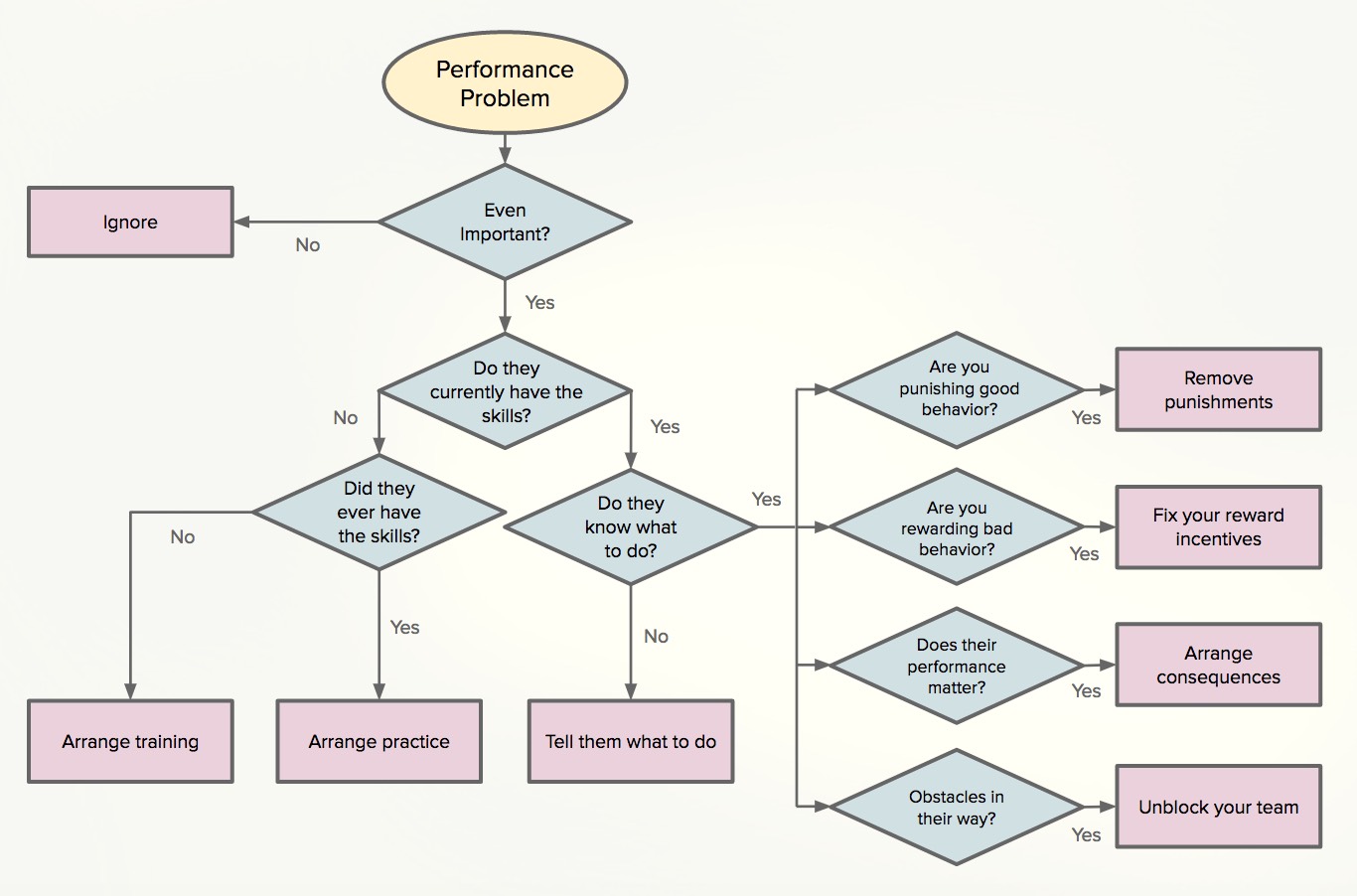Finding the Reasons for your Team's Performance Problems
Great managers strive to create high performing teams. So if they observe or are presented with a problem with an employee, they swiftly seek to understand and solve it. And the best leaders realize the surface issue most likely isn’t the real issue. They need to go below the surface to understand the why.
These “performance problems” usually take the form of “this employee isn’t doing their job well enough”. But a performance problem is much more general than that.
A performance problem is the gap between what an employee is actually doing and what you want them to be doing.
Let’s consider some examples. An employee may:
- Miss deadlines
- Have work that lacks quality and often needs fixing
- Be continually late for meetings
- Receive feedback but doesn’t take corrective action
- Be blocked on a problem for too long before asking for help
- Not share what’s truly on their mind
- Be a detractor who gossips and spreads negativity to the team
- Display aggressive or bullying like behavior in order to “get things done”
- Display a poor communication style (not concise, confusing)
- Shirk responsibility, I.e. going on weekend trip when supposed to be on-call, leaving rest of team to scramble
- Take all the tough work because they think team isn’t competent enough
- Take on too much, working exceptionally long hours leading to burnout
Many managers may rely on their gut reactions to problems like these. The employee “isn’t motivated, isn’t competent, isn’t a team-player, and may not be a fit for my team”. But it’s important for managers to not assume the worst.
The best leaders go below the surface to understand the why. The following framework can help managers get to the “why”.
Step 1: Identify the problem
Remember, a performance problem is the gap between what an employee is actually doing and what you want them to be doing. It’s important to define the problem with facts and avoid any opinion.
| Poor | You work slow |
| Better | Task A should be done by week 3, and you have no progress by week 2 |
| Poor | Your complaining is immature |
| Better | Your observations have a tone that makes many on your team feel bad |
Once you identify the problem, one interesting question you should ask yourself is: “is this problem even worth solving?”. The problem may be real and may exist. However, it may not be worth fixing or may be too expensive to fix. For example, you may not like an employee’s work hours. But at the end of the day, they get their work done and the team is unaffected. That might be a you problem.
Step 2: Identify the source of the problem
In the book Analyzing Performance Problems, the authors suggest working through a simple flowchart to follow to ensure all options are considered. Let’s go through each.

If the problem is worth solving, rule out the obvious: do they have the skills to do the job? If not, arrange training or practice in a safe space. Problem solved!
Are expectations clear?
Next, ask yourself “does the employee even know what they are supposed to do?”. This one is all about setting clear expectations with your employees. Seems obvious but sometimes really simple feedback is all that’s needed. Also, remember no one can read your mind, and what might seem simple to you may require a bit more instruction to someone without the same experience.
MANAGER
When you’re going on vacation, you need to find a backup for your project.
EMPLOYEE
Oh, I hadn’t realized that, sounds good.
Employee SMILES as she walks towards the sunset. She is an woman forever changed.
CUT TO BLACK. THE END.
If expectations given to your employee are clear and you believe they have the skills and knowledge for the work, let’s now consider motivation.
Business management psychologist Frederick Herzberg summarizes two types of motivational factors:
- Obstacles in the environment, and
- Appropriate rewards and recognition
Let’s explore.
Any obstacles in the environment?
It’s common for an employee to be blocked from completing a task - a difficult teammate, a lousy software framework, a challenging work environment (open-office workplace anyone?), or maybe even you as the manager (according to Dilbert). One of the main jobs of a manager is to help unblock your team, so get to it!
“Great leaders remove obstacles-including themselves.” - Royce White
Ok, so if you determine that an employee has the necessary skills, knows what to do, and no obstacles in his/her way, why isn’t he/she doing achieving the end-goal?
Now we’re getting to the interesting part.
Punishing good behavior or Rewarding bad behavior?
A key question to help understand an employee’s motivations is whether you’re rewarding bad behavior or punishing good behavior? Wait, what?? That’s a typical response I get when posing this question. Why would anyone purposefully punish good behavior or reward bad behavior?
Well, it turns out that providing the wrong type of consequences to an employee is super common issue.

Here’s some examples I’ve seen.
- Waiting to start a meeting “until everyone is here”. This punishes the early arrivers and rewards the late arrivers.
- Recognizing the accomplishments of those who bullied their way to completing a project without any mention or condemnation of the bullying. Reed Hastings at Netflix calls this the brilliant jerk. Stanford professor Bob Sutton describes it in The No Asshole Rule.
- Laughing at something someone says which is insensitive at a team meeting.
- Skipping 1:1s with an employee because “we only need to connect if there’s a problem.” This correlates the reward of facetime with a boss only when bad things happen.
- Engaging in microaggressions and unconscious bias, i.e. female employee voices an opinion and gets ignored, while male employee later says same thing and gets recognized. (Combat this by learning How to Be an Ally).
- Rewarding a team for a project that they can solely execute (local optimization), without recognizing the poor choice made in terms of trade-offs like turning down an opportunity at a more impactful cross-team project. Fred Kofman warns this is The Number One Killer of Successful Organizations.
- Rewarding managers for “growing the team” or having a bigger team without placing an emphasis on maintaining team culture and retaining team members.
- Replying in an overly positive way to a long-winded email. You’ve now signalled long-winded is a good thing.
- Over-assigning work to an employee with an impressive work ethic while others on the team are underutilized. HBR describes this as Overloading of the most capable.
Once you start looking for these backwards incentives, you’ll start seeing them everywhere.
Are there appropriate consequences?
Once you’ve exhausted all the possibilities and determine that the root cause is not something which can easily be solved through training or the realignment of motivators for example, it is your job as a manager to make sure your employees understand the implications of the problems they face. Consequences in the form of low performance ratings, performance improvement plans, and firings may be necessary at this stage. If there’s no consequences, well soon enough you’ll have a bunch of coasting employees.
Conclusion
It’s easy for people in any position to assume the worst of co-workers, but there is a good chance there’s benign reasons your employees are not doing the things you want them to do. And it turns out, many of those reasons are relatively easy to eliminate or fix.
Always ask yourself “is my gut reaction about an issue the real issue?”. You can use the framework described here to ensure you’ve considered all the the possible causes and get to the bottom of any performance problem. It’s in your interest to actively spend this time in this area.
High-performing employees = High-performing manager = High-performing company.

